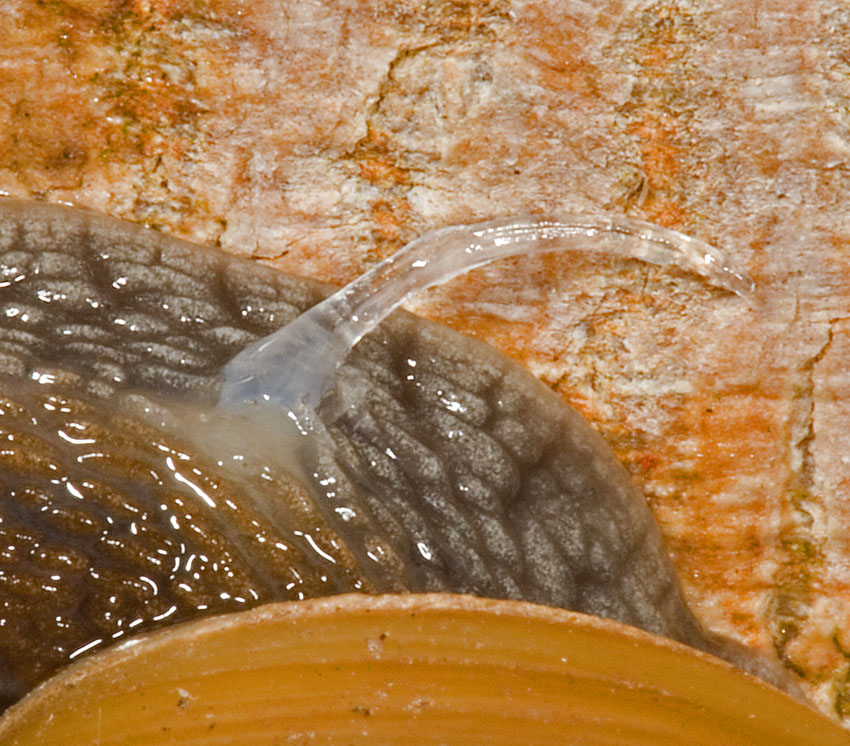Love Dart Shooting in Simultaneously Hermaphroditic Snails
Biology 342 Fall 08
Charlene Grahn and Robin Steitz
MECHANISM
Inside of the Reproductive Tract
The snail's love dart (labelled in the figure below as D) is formed and stored in the stylophore (S), a region of the reproductive tract just inside the genital pore. The genital pore itself (G) is located on the left side of the snail's body, just posterior to its eyes and mouth. During mating, the stylophore is forcefully everted out of the genital pore as the snail attempts to pierce the head of its partner with the dart (Koene and Schulenberg 2005). When a snail is pierced with a love-dart, compounds found on the tip of the dart enter its bloodstream and become effective when the compounds reach the organism's reproductive tract.
The spermatophore is inserted just inside the copulatory canal, or vagina (V) in the maternal snail's reproductive system. When no mucus from the paternal snail is present, the copulatory canal connects to the bursa tract (BT), which leads to the bursa copulatrix (BC), where sperm and spermatophore are digested. When there is mucus present, the copulatory canal opens to the bursa tract diverticulum (BTD), where sperm is stored for fertilization. The presence of mucus also causes peristaltic movements of the bursa tract diverticulum, which aids in transporting sperm up the tract.

"Schematic morhpological drawing of the reproductive morphology of a land snail" - Koene JM and Schulenburg H 2005.
The love dart functions to inject mucus containing biologically active compounds from its digitiform glands into its partner. It is uncertain exactly what compound is responsible for increasing the paternity of the organism delivering the dart, but it is likely to be a peptide since peptides are common in gastropodal neurotransmitters and hormones (Blanchard and Chase 2006). It has also been determined that the specific compound responsible is present in both the digitiform glands and pedal glands, glands located on the ventral side of the snail (Koene and Chase 1998).
In an experiment performed by Koene and Chase, H. aspersa were injected in vitro with mucus from the digitiform glands and the pedal glands. The part of the snail's reproductive tract where a spermatophore from the snail's partner is inserted underwent a structural change upon injection. The path that sperm normally follow when inserted into the reproductive tract rerouted and the part of the tract that leads to where sperm is stored for fertilization began to undulate (Koene and Chase 1998). It is hypothesized that this change causes less of the paternal snail's sperm to be digested by the maternal snail's reproductive tract, as it's estimated that 99.9% of the sperm in a spermatophore is digested when no mucus is injected into the maternal snail(Blanchard and Chase 2006).

Courtesy of www.kingsnake.com/westindian/metazoa1.html. Pleurodontid snail in the US Virgin Islands post-mating, with dart from partner pierced through skin.
Inside of the Brain
The right mesocerebrum is the area of the brain responsible for controlling mating behavior in H. aspersa (Koene et al. 2000). In an experiment performed by Koene et al. dart-shooting was elicited in snails by stimulating the right mesocerebrum electrically while applying tactile stimulation to the genital pore opening. It has been suggested by a previous study that the neurotransmitter FMRFamide was responsible for mediating dart-shooting behavior in snails, however in the experiment run by Koene et. al. dart-shooting did not occur when snails were injected with FMRFamide. It remains uncertain what neurotransmitter might be responsible for mediating the behavior.